Description
Current concise reviews of the albums by adult alternative, contemporary, and crossover artists. Images
of album artwork and links to both internet-based resources are always included. Click on the title to
view the article.
Content
A Girl Called Eddy
Delerium
Bugatti Type 35 (Wendy Bugatti)
Jen Gloeckner
Kitka
Adiemus
Gwen Jennier
Links
Digest Index
More Digest Entries
Previous Digest Entries
Current Digest
Instrumental Digest
|
 |
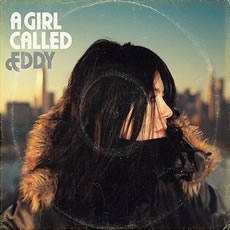
Image © ANTI 2004
|
|
(19 December 2004) How to describe the debut album by New York/New Jersey singer-songwriter "A Girl Called Eddy?" Bacharach-esque with a dose of Dusty Springfield, Chrissy Hynde and pinches of Ray Orbison topped off with a Portishead-inspired modern moodiness? Well--maybe. But, really "brilliant" might be the best adjective to apply. Erin Moran, (aka "A Girl Called Eddy") has, with her first effort, certainly caught the ears of critics and fans alike. With a dusky and effortless vocal style, A Girl Called Eddy (ANTI (USA) 86719-2, 2004) breathes heartbreak and intimacy into each song on her self-titled album. In fact, it is hard to believe that this is "A Girl Called Eddy's" first major release. Produced by Richard Hawley ("Pulp") and Colin Elliot, Ms. Moran exudes the type of vocal self-assuredness that is usually a hallmark of veteran artists. With impeccable instrumentation and arrangments, the 11 tracks on A Girl Called Eddy are imbued with a sensual immediacy that strikes the heart and mind. Take the downtempo "Kathleen," with its deep-brooding guitar rifts, chamber strings and minor chord progression--it is difficult to think of a more perfectly-crafted song than this. The iridescent "Did you See the Moon Tonight" is a perfect romantic gem of classical late-60s folkiness. Simply gorgeous. The sweet and swinging "Somebody Hurt You" is a tender ballad of whispered longing, while the bass-dronings of "Little Bird" create a rich sonic bed for "A Girl Called Eddy's" gentle musings.Drawing upon myriad influences from the past and present, "A Girl Called Eddy" has created something that is both familiar and original. While the overall "vibe"  of the disc is subtly rainy, the warmness of Ms. Moran's vocals and the lazy-day ambience works to wonderful effect. Extremely high marks for this exceptional album.--Justin Elswick of the disc is subtly rainy, the warmness of Ms. Moran's vocals and the lazy-day ambience works to wonderful effect. Extremely high marks for this exceptional album.--Justin Elswick 
|
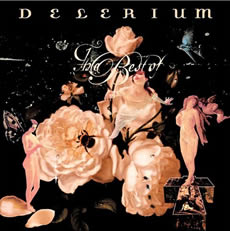
Image © Nettwerk Records 2004
|
|
(01 October 2004) Delerium, the masters of electronic ethereal world-moodiness have released their collection of greatest hits entitled The Best of Delerium (Nettwerk Records (USA) 2004). This release features some of Delerium's best-known songs from their Semantic Spaces album through their most recent album Chimera. Additionally, fans are treated to new remixes of "Truly," "Underwater,"and "Silence." Most welcome, however, are the two previously unreleased tracks: "Paris" featuring french chanteuse, Aude, and "You and I" featuring Zoe Johnston. The Best of Delerium offers a brilliant perspective of the ensemble's lush and innovative music. It is interesting to listen to early songs like "Flowers Become Screens" and "Incantion," (both from Semantic Spaces and both featuring Kristy Thirsk) when Delerium's music was still rooted in the industrial/gothic/enigmatic sound and compare them with songs like "After All" and "Truly," which reflect Delerium's recent transition to more pop-oriented sound.Not that the change has been bad--if anything, it shows that Rhys Fulber and Bill Leeb have honed their songwriting and production skills. And it will be interesting to see what sonic explorationsDelerium will take on their next album. Although now ubiquitous, "Silence," featuring Sarah McLachlan, remains one of Delerium's best musical moments. Who knew that Sarah's sonorous and heavenly vocals would be so perfectly suited to the electronic whirrs, beats and Gergorian monks that inflitrate the song? Kristy Thirsk, who became associated with Delerium's "core" female-vocal driven style can be heard on the subperbly gothic/trip-hop song "Flower's become Screens" and the riveting dance track "Incantation." Frontwoman Leigh Nash of folk/rock band Sixpence None the Richer also grabs to lead vocal spots on the eerie "Innocente" and pop-laden "Run for It." The two new tracks are also magnificent. Aude worked with Delerium on "Terra Firma" from their Poem album--so it can be assumed that the bonus track "Paris" is from that session. Fans of Delerium may be a bit surprised by this one--the melody islifted directly from Pachelbel's "Canon" and Aude sings in French. Although the opening of the song borders on the slightly cheesy, that the song ultimately displays its own certain sweet charm! The melody is everso memorable. Zoe Johnston--who has worked with Brit bands Faithless and Bent--lends her throaty alto vocals on "You and I." The opening saloon-piano and Abba-esque melody are quite innovative for a Delerium song. Think Annie Lennox singing with Erasure. "You and I" is an attractive song that showcases Zoe's ever-intriguing voice. The Best of Delerium is a perfect starting place for newcomers to the Delerium sound.  Evocative, haunting and propulsive, the album takes the listener on a fantastic exotic aural voyage.--Justin Elswick in Utah and Russ Elliot in New York Evocative, haunting and propulsive, the album takes the listener on a fantastic exotic aural voyage.--Justin Elswick in Utah and Russ Elliot in New York 
|
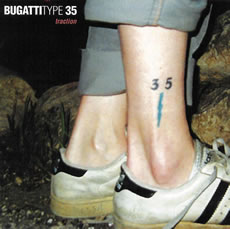
Image © Jollydog Music 2001
|
|
(07 November 2004) Traction (Jollydog Music (USA) JDM 10-17-25, 2001) is the second release by Bugatti Type 35, an Indie Rock/Post Punk Band that is a minor legend in the Midwest and well revered as a local trio in Madison (The Mad City) Wisconsin, home of such bands as Garbage. The band is reigned over by extremely versatile singer/songwriter, guitarist, recording engineer, producer, and entrepreneur, Wendy Bugatti. Her voice is intuitively emotive and within the raw timbre of her vocals there is a grave earnestness and a somber rasp that hits a nerve quite often throughout the album. She is supported by Par Farny on Bass Guitar and back up vocals and Mike Henry on drums. The incredible rhythmic interplay between these three musicians creates a kinetically organic equilibrium. At times it's raw and loud, but it's never just noisy. Melodically, their sound is full of dilemma and resolution, at times dire and then assuaged. There is a fierce integrity and perceptiveness to Bugatti's writing, Delivering a social consciousness to her work, and yet it is tempered by a very personal sensibility. Bugatti's guitar is beautifully edgy and dissonant, just underscoring her uncompromising vocals even more. Farny's bass guitar is definitely the conduit to which the pulse of the band courses. And Henry's drums exhale and contract like a visceral machine. There are twelve offerings from this Heartland pilgrimage, inhabited by lost souls and damaged innocence, in a complex world where nothing comes easy. Yet it doesn't come across self-conscious of the message. The songs are thoughtful and honestly from the gut. The style is often reminiscent of Patti Smith, and at times Bugatti's performance evokes thoughts of PJ Harvey. The particular tracks that stand out the most were "Oh Lord" whose lyrics call forth the image of Sisyphus stoically rolling the bolder up that hill. Our most favorite and likely the most memorable track would be "Jimmy." An intensely serious anthem of the self-destructive personality. The verse makes mournful advances with lines like "Maybe this year we'll skip June. Too much to get through this summer. I don't mind where you take me. I don't mind if you drive. Just don't stop the car in June." Then the song erupts into the vast exposure of pain, anger and betrayal as we are the helpless bystanders to the events. She cries "Castaway," as everyone involved remains now in exile from the experience. This would be an incredible video for MTV fodder. This sentiment carries over into "Give Me A Sign." Yelling out to the collective social miscreants, human wreckage and the disillusioned. "It's a long walk home, when you lose your direction. "Contain" and "Let It Ride" are very powerful as well. Melodically and lyrically. "No birds fly over to you they only fly away." The album concludes with yet another strong track and perhaps another favorite is "Andy Told Me Yesterday," which is threaded with portions of Bugatti's interview with local legend street blues guitarist Catfish Stevenson. Regarding his life experience tethered in the blues and his "dancing with the devil" so to speak. This is definitely for aficionados of emotionally grainy vocals and synchronistically precise musicianship. Traction never sounds nihilistic. It's harsh at times bit doesn't settle in darkness. It's realistic but not contrived. There is a sense of rescue beneath the outraged roar.--Jo Gabriel in Madison, Wisconsin 
|
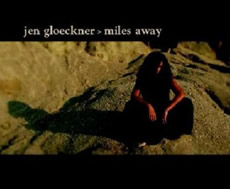
Image © Jen Gloeckner ASCAP 2003
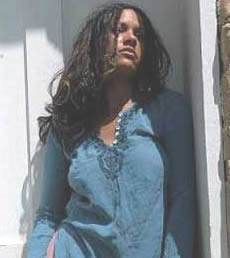
Photo © Sarah Ehrler 2004
|
|
Miles Away (Hazy Sky Publishing Spinning Head Records (USA), 2004) is the debut album for alt/folk, alt/jazz, alt/country singer, Jen Gloeckner. With words and music as well as production by Jen, this self-releasedalbum is certainly a one-woman effort. She contributes a proficient acoustic guitar, keyboards, vocals and harmonies to the array of melodies. Jen's voice has a striking similarity to that of Stevie Nicks and therefore this album is likely to appeal to her fans as well. Jen approaches her music gently, with slow-moving tunes, in a husky, twangy vocalization. Her laid-back approach conveys a moodiness to her songs. The title track, "Miles Away," opens with wonderful guitar riffsand has a gentle, lighthearted feel. "Remember When" continues with soft strumming of the guitar, and her almost nasal vocals. She changes to a more upbeat melody in "Hazy Sky," yet she still captures the relaxed and lazy mood with her impeccable guitar. The haunting "Seven Maids" follows with Jen's wonderful storytelling style. Drums by OlenFranklin and cello by Kameron Cole certainly add to the hypnotic approach to this tune. "Nothing Personal" has a wonderful mix of percussion and down-home vocal expression. Another stand-out tune is the upbeat "Clear the Sand." Some amazing flute solos by Jen Wiater and congas by Olen Franklin contribute tothe rhythmic and gripping music. Having been likened to numerous female artists including Tori Amos, Joni Mitchell and Stevie Nicks, Jen comes into her own on this traditionally rooted album. This Iowa born singer/songwriter has certainly created an album that has expression, a variety of moods, and an intimate feel. Talented Jen Gloeckner is certainly an artist to keep watching out for in the future. has expression, a variety of moods, and an intimate feel. Talented Jen Gloeckner is certainly an artist to keep watching out for in the future. 
|
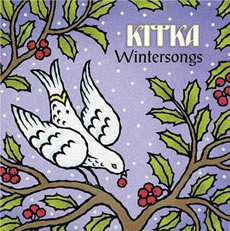
Image © Diaphonica 2004
|
|
(29 December 2004) Kitka is a musical bouquet of eight women singing in a refreshingly beautiful meditative solstice within the recitation spirit of Eastern European magical sounds. The ensemble features the following floral arrangement of singers: Shira Cion; Leslie Bonnett; Catherine Rose Crowther; Deborah Dietrich; Juliana Graffagna; Janet Kutulas; Ann Moorhead, and Lily Storm. In many Balkan folk songs, the word Kitka appears not only as a literal 'bouquet' of flowers but as a symbol of alternatively, feminine purity, fertility, love and/or beauty. For us as an ensemble, Kitka represents a gathering of women with very distinct voices, ethnic and musical backgrounds, and individual personalities, that, when put together musically, aim to create something that is as beautiful in its whole--or perhaps even more beautiful in its whole--as it is in its individual parts. "Kitka is also a word that is really fun to sing!" says Shira Cion, Executive Director/Vocalist. "To me it's just the beauty of harmony made up of diverse individual sounds, idea, personalities. Unity through diversity somehow creating beauty," adds Catherine Rose Crowther/Vocalist. And it is just this gathering, of open-voice 'feminine purity' that symbolizes to the CD listening world the vocal and beautiful, figuration, of Kitka. In a time signature of songs once forgotten, Kitka opens with "Tec, Peleite, Zêrnju, Zogtu," which is rhythmically sung in the ritual rich historical language of Latgalian, an archaic language from the Baltic region of Eastern Europe. It sings to the listener with a good blessing of dissonant voice intervals that eventually form into a full tapestry and ensemble of vocal distinction. The instrumental interlude of violist Leslie Bonnett also figures prominently in this musical lush figuration of ancient sound. The second track "Byla Cesta" is an early 19th-century carol that is vocal ear nourishment, which is lyrically administerd by the genteelly applied tongues, of lead vocalist Lily Storm and the almost lead vocals, of Leslie Bonnett. "Oj, U Horodi," the twelfth track, is sung within a well-arranged temporal arrangement of time. It is vocally asymmetrical, and contains an excellent sounding interplay between the accordion (Dan Cantrell) and Peter Maund on snare drum. Melodically feminist, this is a beautiful song about a New Year’s celebration and gathering of many young women. Kitka closes with their opening-voice coloration of "A v Jerusalime," a Christmas audio postcard that sings to us, the listener from Russia with love. Produced by Linda Tillrey along with co-producers Janet Kutulas and Juliana Graffagna, Wintersongs is a twenty-track Trans-Baltic linguistic  journey into the embroidered power and passion, and oral ornamentation, of magical words, transformed, into magical sound.--Steven Digman in Maryland and Russ Elliot in New York journey into the embroidered power and passion, and oral ornamentation, of magical words, transformed, into magical sound.--Steven Digman in Maryland and Russ Elliot in New York 
|
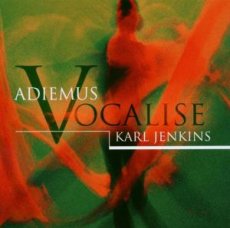
Image © EMI Classics 2003
More Vocalise Reviews
Paul Van Vliet
More Adiemus
Adiemus IV - The Eternal Knot
Adiemus Live
Adiemus Live (March 2001)
|
|
(14 October 2003)Karl Jenkins's Adiemus has been a very successful "project" worldwidely; already since the initial launch of Delta Airlines TV jingle and the follow-up albums there have been both albums released and concerts arranged around the world. The discussion of not being able to label or pigeonhole the genre of Karl's music can well be continued with the latest Adiemus release, but the old proverb about what the bride should be wearing at her wedding suits exceptionally well into the concept of Vocalise. Something old, something new, something borrowed, and something blue, as the thing goes. That's also the basis how I have built this review. Let's start with things that are "old": Firstly, Karl's unique concept of mixing various musical styles and genres is still strongly present on the latest album, though in every album he has managed to develop the style even further on. On Vocalise, there are also lots of musicians that have been involved in making music with Karl for a long time, so the professionality and flexibility of them is not a new thing for the listeners. Martin Taylor, Pamela Thorby, the fabulous Finnish team of nine female singers, Mary Carewe, the strings of London Philharmonic and Nigel Hitchcock are all very skillful and are really at their very best when they are playing this music together! Stylistically the usage of ethnic percussion is also a previously used (and great) feature of Adiemus' music, as well as Karl's stunning ability to make the music sound melodic but simultaneously exciting. The unique, invented "Adiemusnese" language and wonderful ability to orchestrate the music have also been Karl's trademarks, and on this album both are cultivated in a refined way. But what are the new things then? The most significant change that may annoy some of the most long-standing Adiemus fans is the absence of the "magical" vocalist Miriam Stockley, but in my opinion it isn't that bad after all. Vice versa, I think that the Finnish singers who are mainly responsible for the vocal solos alongside with Belinda Sykes (track 4 only), countertenor Terrance Barber, Mary and bass voice Gavin Horsley are all now succeeded to complement each other very well! The entrance of the new musicians such as blues harmonica player Mark Feltham, the cellist Richard Harwood, the flugelhorn player Kenny Wheeler, the new vocalists as well as Karl Jenkins himself (playing all those great piano parts on the album!) has brought Adiemus into a new dimension of making music. This way, each track sounds a bit different, but still the concept retains the cohesiveness all the time and avoids becoming too versatile. Secondly, not all compositions on this album have been made originally by Karl, whereas the originality has been the case with all previous compositions on Adiemus albums. This time, in addition to his own compositions, Karl has drawn material mainly from classical and contemporary music repertoires, and brought his Adiemus style to entirely new world by combining already composed material with his own ideas and elements as well as introducing "real" language lyrics (English, Latin, Welsh, Portuguese, Punjabi, even a German word "tänze" meaning dances) into his music in addition to the invented Adiemus "language" (used e.g. on tracks 1, 3, 6, 10 and 16) and pure title-fragment repetition (on tracks 4, 5, 9, 13 and 14). Some kind of a cross-fertilization or "hybrid music" with quite surprising new dimensions I think, so this change may also be one thing that may annoy some of the listeners. But, in my opinion every artist should have the right to experiment and develop their music with new ideas rather than just resting on laurels and make "similar" music album after another. And Karl Jenkins really seems to be a master of surprising his fans. So, this leads to the third component of the proverb, borrowing. With his versatile choice of the pieces and composers to be versioned, Karl shows his great knowledge of music history, and this results as a fruitful combination of simultaneously inventing new things in order to not spoil the original pieces' ideas and structures. It's not a compromise at all, but indeed a result of the hard work by a skillful composer. Among the "other" composers than Karl himself are Beethoven ("Rondo" originates from Violin Concerto and "Allegrettango" from Beethoven's Symphony No. 7), Chopin ("Akruzam", or one of his mazurkas), Jaromir Weinberger (A polka from an opera "Schwanda the Bagpiper"), Schubert (one of his piano duets is now "Schubert's Dance"), Villa-Lobos (a new version of his aria from "Bachianas Brasileiras No.5"), and Rachmaninov (Vocalise Op. 34 No. 14). Obviously classical music purists would not like these new arrangements very much, but for me re-arranging them means giving the listener a chance to hear the music in different "angles" in different light. Among Adiemus fans there may be many who have not been fans of classical music, but listening to Adiemus V may give them a totally different attitude and maybe broaden their musical tastes a little bit more. That's what I hope to happen, the listener really needs some sort of an open-mindedness to digest the new approaches. In addition to borrowing from other composers, Karl has once again borrowed things from his own compositions which is not new at all. I don't know how much of the borrowing has happened subconsciously and how much of it is deliberately done when speaking of this new album, but most of us may recognise the piece "Bendigedig" being developed from "Good Night, House of Dewi" from Karl's recent choral-orchestral work "Dewi Sant" (having also a bit in common with Adiemus' piece "Beyond The Century"), as well as "The Protector" (which is a new, Merry-Christmas-To-The-World-style rendition of a choral piece "The Lord, Our Protector" originally made for a boy choir album featuring Tristan "Armed Man soloist" Hambleton a couple of years back). But in addition to these there is one more Jenkins composition that has been previously recorded. This track, "Berceuse Pour Un Enfant Solitaire", deserves a special mention here, because the new version of it reminds beautifully of Karl's musical past as a jazz musician and composer. Namely, before embarking his career as a commercial music composer, Karl co-formed a jazz-rock group Nucleus in the 1970s and the original form of his composition "Lullaby For A Lonely Child" can be found from Nucleus album "We'll Talk About It Later" dating back to 1971. This particular track then forms the "blue" part of the figurative proverb, alongside with e.g. "Akruzam", both featuring bluesy, sliding, almost jazzy (vocal) harmonics, dreamlike, highly improvised piano parts and great orchestration. I think that the usage of plenty of improvisation on both singing and orchestral parts derives from Karl's jazz-rock past as well, but here it blends very well with the original Adiemus concept. A cross-fertilisation at its best I think! Thanks to the versatility and the brave experimenting, the album provides musical experiences for almost every taste. For example, Jaromir Weinberger's "Schwanda" polka would well be even composed by Karl himself, and the catchy "encore" track Boogie Woogie Llanoogie should make everyone's toes tap at least a bit! Karl's piano playing shows his musicianship fully, and it seems that every single one of the musicians (including Karl of course) have enjoyed themselves and had fun together making the recording!. Some listeners would not like the breathy vocals used on many tracks, but if not taking the tightness of the vocals in the middle of "Schubert's Dance" into account, I think that Karl Jenkins has once again succeeded to make wonderful music with wonderful musicians and singers! Of course it would be even more nice to see all these songs performed live in concert (also elsewhere than in just UK, Spain and Japan!), but in the meantime I highly recommend every Jenkins/Adiemus fan (and why not others as well?) to obtain the latest Adiemus album, Adiemus V - Vocalise! Read further reviews, listen to soundbites and orderthe album from amazon.comhere. An album certain to interest long time Adiemus fans inits development from previous works and introduce thematerial to new listeners, further investigation is certainly worth a journey. An album certain to interest long time Adiemus fans inits development from previous works and introduce thematerial to new listeners, further investigation is certainly worth a journey. 
|
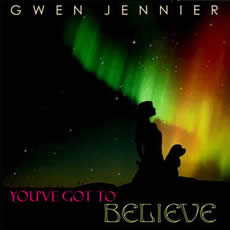
Image © Angel Dog Music 2003
|
|
(03 Aug 2003) Gwen Jennier, a native of Alexandria, Virginia has been making music and writing songs since she picked up her first guitar at the age of eleven. The debut of her first inspirational Christian CD, You've Got To Believe (Angel Dog Music (USA) ADM114801, 2003), is the fulfillment of a life long dream. The music on the album is up-tempo, with a variety of styles--country, 50s rock, dance/techno and ballad/folk. The arrangements are dynamic and each song is differ4ent, but all ten songs are reflections of the best of inspirational music from the quiet reflective prayer of "The Gift Of Love" to the fast, hard-hitting techo sound of "The Vision" or the country twang of "Rocking Horse" and "Looking for the Faith." Gwen's early musical influences were the folk singers of the 60s and of course rock and roll--bands like the Rolling Stones and individuals such as rock diva Tina Turner. Over the years, Gwen has performed solo and as a member of several locak bands, but for the past decade she has spent her time not performing, but writing. She wrote her first contemporary Christian song, "I've Seen the Light" in 1995. "I've written a lot over the years--mostly rock songs, some folk, a little country. And then I wrote, "I've Seen the Light." I played it for my church's choir directory and then for the congregation with the choir backing me up. We had the whole church rocking." Gwen has a deep respect and love for animals. "To love God is to love all of his creation and to me that means animals and nature." Two of the songs on the CD reflect this love, "I Need to Know" and "Wondrous Love Wondrous Nature." The other eight original songs mirror Gwen's own life journey--the joy, the pain, the doubt--reflections of feelings most of us experience in our lives, with lyrics that are inspiring and honest.  You've Got To Believe< is great music with a great message. Listen to soundbites, read further reviews and order the album from amazon.comhere. You've Got To Believe< is great music with a great message. Listen to soundbites, read further reviews and order the album from amazon.comhere. 
|
|















